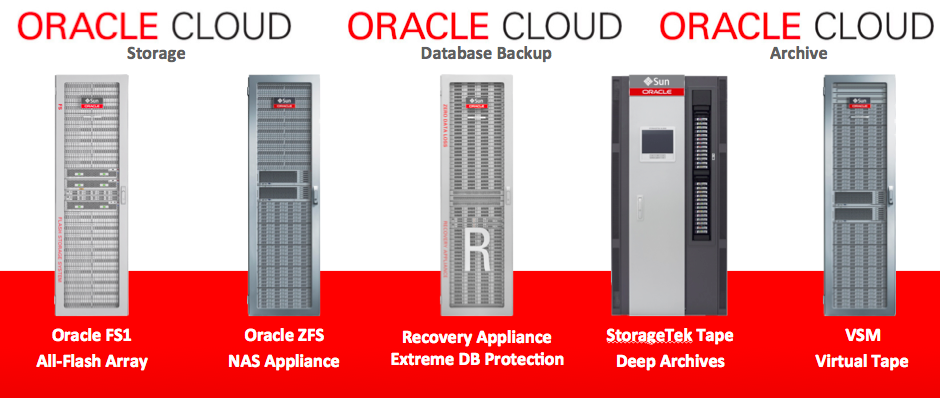Contributors:
Dave Vellante
David Floyer
Premise: As the price of storage continues to plummet, across all media and consumption types, the focus of Oracle storage teams must radically shift to application enablement and data management. Wikibon has called the end of the storage era. Wikibon believes that demands for lower cost systems with improved functionality and agility will mean that enterprise CIOs and their line of business customers will shift their focus to converged infrastructure systems, true cloud-based storage offerings, and more robust policy and data management that simplifies environments for application and database teams. In anticipation or response, storage vendors and providers will have to shift their focus to provide such services.
This research note provides a summary and first pass opinion of Oracle’s Storage Cloud strategy and the degree to which it supports this premise, and what it means to enterprise IT management. To date we have not spoken with customers to vet Oracle’s claims but plan to do so in the future.
Introduction – Cloudy Changes Ahead
Two of the most significant trends that Wikibon is tracking are the rise of Public Cloud usage and the evolution of storage towards the Server SAN model. The growth of these two mega-trends points to the changing buying and usage patterns of application and infrastructure teams. Application teams are more open to using agile Public Cloud services, especially for object storage and data management, and operations teams are attempting to simplify their internal data centers by shifting to greater usage of converged infrastructure platforms.
For enterprise IT with large traditional “stove-piped” infrastructure, this will require a significant shift in strategy and change in the IT organization to support converged infrastructure platforms. For incumbent infrastructure vendors that supply the piece parts, this trend can be viewed as a significant threat to their existing technologies and business model. IT senior management will need to partner with vendors that are embracing these trends and reshaping their business, and create new strategic partnerships. The vendor landscape for these strategic partnerships will change dramatically over the next decade.
To that end, we believe Oracle is one of those companies committed to the vision set forth by its Chairman Larry Ellison to deliver consistent, secure and robust services both on and off premises. Given Oracle’s history of investing heavily in R&D we expect the company to deliver on its promises over the long haul. However we caution Wikibon Oracle practitioners to carefully evaluate the maturity of specific storage services to ensure Oracle’s current claims are met.
Overview – Oracle Storage Cloud
Enterprise organization often have unique operational and compliance models which make it difficult to take advantage of the economies of scale that Cloud Providers can potentially provide. Technology vendors need to provide high levels of automation, orchestration and self-service (via APIs, rolling updates, global availability zones, scale-out architectures, etc.), and be able to fit in with enterprise IT mandates.
The Oracle Storage Cloud brings to market a unique perspective on how to blend those two operational environments into a cohesive offering for Enterprise companies.
At the core of the Oracle Storage Cloud offering is a foundation of Oracle Storage Arrays, Appliances and Engineered Systems. These systems can be deployed either on-premises or as services within the public Oracle Storage Cloud. By building and managing these systems in either Private or Public environments, Oracle is able to bring deep engineering expertise to the deployment, performance and maintenance of these systems.

Oracle Storage Cloud augments these systems with three additional services that are critical to current and future Enterprise Applications:
- Oracle Database Backup (as-a-Service) – Direct backup and end-to-end monitoring and diagnostics of Oracle Databases using the integrated RMAN tools.
- Object Storage (as-a-Service) – The fastest growing segment of storage, object storage is unstructured data that is used for web and mobile applications.
- Archive Storage (as-a-Service) – Long-term retention of critical data, focused on industry and vertical compliance requirements.
The Storage Cloud and Archive services are available individually as part of the Oracle Storage Cloud, but they also create the foundation for other Oracle Cloud services, such as Oracle Cloud PaaS (Platform-as-a-Service) – which integrates with Oracle’s Database Backup cloud service – and multiple Oracle Cloud SaaS (Software-as-a-Service) applications.
But just delivering technology is not enough to remain competitive in a world where Public Cloud services are available and being rapidly adopted by enterprise IT . Enterprise IT must ensure that cloud vendors bring true operational expertise and flexibility to the table. This can not be under-estimated in terms of customer evaluation criteria. Cloud operational skills are some of the most complex and sought-after in the industry.
Oracle aspires to leapfrog its Enterprise competitors in this context. With the acquisition of global Storage Cloud provider Nirvanix, in Dec. 2013, Oracle picked up the remnants of an early cloud-storage pioneer with deep operational experience in large-scale cloud environments. This level of expertise is critical to Oracle’s success, potentially enabling Oracle to embed that experience and technology into future Oracle Engineered Systems and storage appliances. This will be important to Oracle’s Hybrid Cloud offerings in the market.
Storage is Cheap, But Data is Valuable
The classical IT operations way of thinking about storage was to focus and optimize on cost-centric measurements: $/Gb, $/KwH, $/FloorTile. Unfortunately, this approach runs counter-intuitive to the growing trend by companies to keep larger and larger amounts of data for current and future insight into the business. This critical data is stored in large-part within mission-critical Oracle databases. But it’s also stored in unstructured systems as well, in the form of images, videos, logs, metadata, telemetry and other system information. Attempting to restrict the capture of this information can create a competitive disadvantage to businesses that are going through digital transformation internally and with their customers.
With this trend in mind, Oracle is aggressively entering the Cloud Storage market with pricing that appears to be 20%-80% lower costs than other leading Public Cloud providers.


NOTE: Amazon AWS does not have a specific Backup Storage service, but Backups and Snapshots can be done to either the S3 or Glacier service, which can be replicated across geographic availability zones. If customers want to leverage RMAN in this scenario they would have to license RMAN from Oracle for each individual RMAN stream. Oracle’s pricing for its public cloud database Backup Service allows unlimited RMAN streams.

Oracle is shifting the challenge for IT organizations from cost-management to data-management, ostensibly enabling them with a set of tools that will allow them to seamlessly manage data either on-premises or in the Oracle Cloud. By focusing on policy-based management of Enterprise data, Oracle is allowing their customers to better align a data-management decision to a business decision. This policy-based management can be accessed through Oracle Enterprise Manager, RMAN, OpenStack-compliant APIs or console CLIs.
One common usage example is using Oracle Database backups in the Oracle Cloud allows companies to enable Development and Test teams to quickly spin up compute resources as new applications or features are being built, in the time-schedule that best aligns to their business needs. The mission-critical data remains secure on-premises, but this capability allows the teams to be agile and move quickly, as they don’t have to wait for new infrastructure to be procured or provisioned.
In addition, the integrated replication capabilities of the Oracle Storage Cloud allow for granular multi-site replication with a just few clicks. This allows applications and infrastructure teams to geographically place the data where it best meets business requirements, and provides the protection needed to meet security and compliance requirements. By using the same backup workflows as the previous example, customers replicating the data across Oracle Cloud data centers can create a robust Disaster Recovery environment for critical Oracle applications.
Cloud is about Applications and Data
While the Public Cloud market has been rapidly growing and offering new types of services, there has been one glaring hole that has yet to be adequately addressed – running Oracle Database and Oracle applications in a Public Cloud environment. This is surprising given that Oracle Database is the #1 database in terms of usage and interest. While some capabilities are available in the marketplace, they are often not optimized for licensing, performance or monitoring visibility. This is where the Oracle Cloud has a distinct advantage over alternative services or solutions.

Wikibon research has frequently highlighted the value Oracle brings to customers with database awareness that’s integrated into their Appliances and Engineered Systems. But this value now extends beyond the data center and into the Oracle Cloud. By deeply integrating with RMAN, Oracle customers are able to manage backup, cloning, data migration and data encryption across any Private or Public Cloud environment. Many cloud services only offer monitoring up to the hypervisor layer, often requiring additional 3rd-party tools to gain visibility into the database or application layers. Oracle’s ability to span well-known tools across multiple Cloud environments will simplify operations and reduce costs for Application, DBA and Storage teams.
The Challenges of Data Gravity and Data Movement
While network bandwidth continues to expand and improve to 40Gb/s and 100Gb/s speeds, it still continues to struggle to keep up with the exploding growth of data from millions and billions of sources. And these bandwidth challenges are amplified when connecting across the public Internet. Oracle addresses these challenges in a variety of ways, giving customers multiple options to move large amounts of data between a Private and Public Cloud environment:
- By partnering with global mega-datacenter operator Equinix to bring direct, high-speed network access from Equinix’s Cloud Exchange to the Oracle Public Cloud.
- By placing a NAS or ZFS Appliance on the customer’s premises and then shipping it to the Oracle Public Cloud.
- By accepting hard-drives directly from a customer to the Oracle Public Cloud (future).
This variety of data movement options allows customers to choose the model that best fits their data capacity needs and their security and compliance guidelines. By offering all of these options directly to customers, Oracle is able to ensure the overall customer experience. This helps to reduce or eliminate security and logistics risks for customer data.
Action Item: For Oracle customers, the breadth of the Oracle Public Cloud and Oracle Storage Cloud offerings is an excellent approach for building a Hybrid Cloud strategy and architecture. Oracle customers should begin evaluating the maturity and applicability of the Oracle Storage Cloud to understand how it can lower operational costs by reducing storage management labor costs. The on-demand nature of the Oracle Cloud services should allow customers to determine what skills need to be augmented for the Applications and Operations teams, as well as determine ways to streamline and enhance their current processes.


